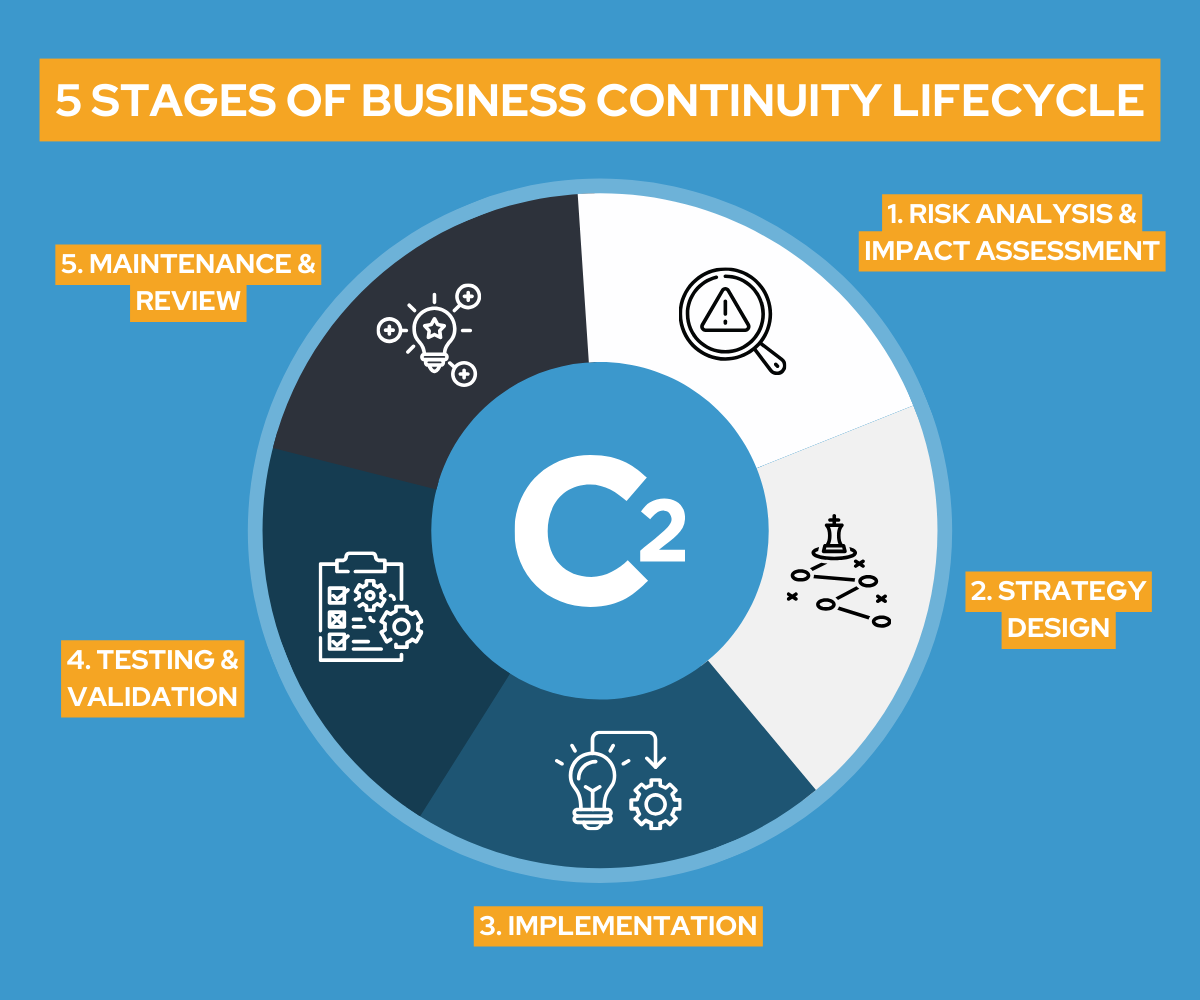BCM Lifecycle: 5 Stages of Business Continuity Lifecycle
Published on November 08, 2023
Last updated on June 25, 2024
Jump to a section
Business continuity planning is a crucial strategy for any company, regardless of size or sector, looking to safeguard against unexpected events and challenges. Your ability to foresee potential disruptions allows you to reduce these risks and keep critical business functions continue uninterrupted.
Business Continuity Lifecycle is then a key framework that guides the development of your business continuity plan to ensure your business operations can withstand even the most disruptive events.
5 Stages of Business Continuity Lifecycle
A thorough grasp of the business continuity lifecycle ensures your organisation's ability to adapt and bounce back from any disruptive incidents. It's a multifaceted process that involves five stages:
- Risk Analysis and Impact Assessment
- Strategy Design
- Implementation
- Testing and Validation
- Maintenance and Review

Here's a rundown of each stage in detail.
Stage 1: Risk Analysis and Impact Assessment
The process of BC planning often begins with identifying potential risks and their impact on your business. This involves conducting a business impact analysis to gather essential data, which forms the basis of your business continuity strategy.
Risks, both internal and external, can emerge from different areas and in various forms, from operational (supply chain disruption) and compliance (ever-changing, stricter regulations) to financial or economic (rising costs) and threats (cyberattacks).
Once risks are identified, think about scenarios in which these risks could disrupt your business operations and evaluate the severity of their potential impact to prioritise your response efforts. For example, interruptions or distortions in the supply chain can lead to delays or even pauses in the execution and delivery of your goods or services.
Stage 2: Strategy Design
With the data from risk assessment, you can now develop your business continuity strategy. This stage includes developing:
Risk Mitigation Strategy
This is where you focus on identifying, prioritising, and executing proper controls and countermeasures to minimise the likelihood of a specific risk/threat or to limit its impact to the minimum when it does. An example would be diversifying your supplier base and establishing backup sources for critical materials.
Recovery Strategy
A recovery strategy is a roadmap for how and when your business will adjust its response to disruption, which can vary given there are different kinds of risks/threats.
With the supply chain disruption, for example, your recovery strategy should detail the steps to switch to backup suppliers quickly. It should include predefined trigger points for when to initiate alternative arrangements, the process for engaging with secondary suppliers, and the communication plan (which will be discussed later on) to manage expectations with customers and stakeholders. The strategy would also specify the recovery time objectives (RTOs) for resuming normal supply chain operations to ensure that you have a clear timeline for action and recovery.
Resource Allocation
Once critical business functions are identified, with potential risks and plans to mitigate their effects in place, it gives a clearer picture of where your priorities should be and what is at stake for your business — the inability to assess or compare value creation potential is the top barrier to resource allocation*. In the case of supply chain disruptions, prioritising resources might involve securing contracts with alternate suppliers or investing in inventory management technology to quickly respond to any shortages.
Crisis Communication Plan
Any of your plans and strategies won't work unless it's communicated. With a clear, timely, and effective exchange of information, crisis communication enables coordination among teams, facilitates decision-making, and helps maintain stakeholder trust during crises. This allows you to manage expectations, reduce confusion, and provide direction, which is crucial for minimising the impact of disruptions and maintaining operational integrity.

Also read: Crisis Communication Best Practices
Plan Documentation
It's best, and often mandatory, to document your business continuity plan. This ensures that every team member is aware of and can fulfil their specific roles and responsibilities during a
Stage 3: Implementation
This is where the strategies and procedures that you have carefully developed are tested in the real world. It is a true test of the organisation's resilience and ability to operate under adverse conditions. The success of this phase largely depends on the quality and detail of your BC plan.
Stage 4: Testing and Validation
Regular BC testing and validation of the business continuity plan helps confirm its effectiveness. This involves exercises, surveys, and drills to identify and address weaknesses, as well as training for personnel to ensure they are prepared to execute the plan.
Stage 5: Maintenance and Review
The final stage is the continuous maintenance and review of the plan to adapt to new risks and changes in the external business environment. This ensures that the business continuity plan remains current and effective, with adjustments made as necessary to manage risks and recover from any disruptions efficiently.
Best Practices in Business Continuity Planning
- Conduct a Business Impact Analysis (BIA) – A thorough business impact analysis is the cornerstone of successful business continuity planning. It enables you to identify and evaluate potential threats and their possible effects on your organisation. Initiating your plan
- Engage all stakeholders – Involve key stakeholders to ensure transparency, align all parties, and foster a culture of preparedness within the organisation.
- Regular updates and reviews – The business landscape is constantly changing; stay vigilant by regularly updating and reviewing your plan to address any new external threats that could compromise your operational stability.
- Utilise BCM software – A business continuity management software like C2 Meridian can significantly enhance the efficiency of your planning. Such software offers a centralised database for information and facilitates improved coordination among different teams, improving oversight across the entire BCM lifecycle.
- Regular drills and scenario-based training – Test your plan through regular drills and training based on realistic scenarios; this ensures that your organisation is better prepared and can respond effectively to actual disruptions.

Next Step: Your BCM lifecycle
The key takeaway for businesses is to recognise that business continuity planning is a dynamic process. It requires a proactive approach to identify emerging threats and adapt strategies accordingly. By integrating best practices such as regular BIAs, stakeholder engagement, and the use of BCM software, companies can ensure they are well-equipped to handle the unexpected.
Continuity2 has been empowering the resilience of organisations across the world for the past 20 years. We know the discipline inside-out, and our CEO even helped standardise it (BS25999 & ISO 22301).
But it's not just our inherent knowledge of BC that separates us from the market; it's our attention-to-detail UX designers who work every day to make your job easier, our developers who keep C2 Meridian BCMS on the cutting edge of industry technologies to ensure you can do your job faster each day, and our dedicated service delivery team who guarantee you feel incredibly supported at all times.
So, it goes without saying that we believe our Meridian business continuity management software is simply the best on the market. But don't just take our word for it. Book a demo today and see for yourself how we can help your organisation.
Written by Aimee Quinn
Resilience Manager at Continuity2
With an Honours degree in Risk Management from Glasgow Caledonian University and 6+ years in Business Risk and Resilience, Aimee looks after the design and implementation of Business Continuity Management Systems (BCMS) across all clients. From carrying out successful software deployments to achieving ISO 22301, Aimee helps make companies more resilient and their lives easier in the long run.


Written by Aimee Quinn
Resilience Manager at Continuity2
With an Honours degree in Risk Management from Glasgow Caledonian University and 6+ years in Business Risk and Resilience, Aimee looks after the design and implementation of Business Continuity Management Systems (BCMS) across all clients. From carrying out successful software deployments to achieving ISO 22301, Aimee helps make companies more resilient and their lives easier in the long run.